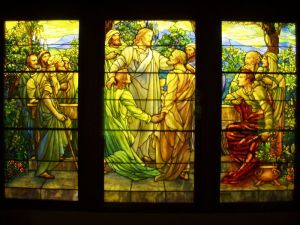Question: Look carefully at this picture of assembled Catholic cardinals, and decide (carefully, now): Which of these, in terms of Pope Benedict's own reasoning, are "excluded from God's People"?
Answer: If you are to follow the line of reasoning of Pope Benedict himself, in his earlier incarnation as head of the Congregation for the Doctrine of the Faith, the answer should be plain to see: all of them.
How so?
In the first Church document dedicated to the matter of homoerotic relationships, "Homosexualitatis Problema", the "Problem (sic) of Homosexuality", Pope Benedict (then Cardinal Ratzinger) quotes two verses from Leviticus which appear to condemn homosexual relationships, and then leaps to the completely unsubstantiated assertion that, because these verses describe such actions as an "abomination", the people so described are "excluded from the Kingdom of God."
If we are to accept the reasoning as sound, we should be able to apply it equally to the other behaviours which are similarly described as "abominations", and so discover who else are "excluded from the Kingdom of God."
These verses include in their condemnation those well-known disreputable sinners as the eaters of shellfish and rabbits, those wearing clothing of mixed fibres, and (it pains me to say this), those who have shaved their beards. Now, the picture shown does not show a great deal of detail, but I fail to see a single beard among the assembled throng. To be consistent, on the basis of this argument we have only two options: either we must accept that the illustrious cardinals shown (and the overwhelming majority of all clergy) are likewise "excluded from God's people ", or we must accept that the reasoning is flawed. Which is it?
"Homosexualitatis Problema" concludes with two wonderful verses from Scripture: "You shall know the truth and the truth shall set you free" (Jn 8:32), and "Speak the truth in love" (Eph 4:15), both stirring verses that I would endorse fully. What enrages me, is the deceitfulness, the utter dishonesty, of a document which purports to be about "Truth", but instead bolsters its claims (for that is what they are: claims, not reasoned arguments) with a long series of palpable falsehoods.
I could accept in good faith a document that submitted ts claims and supported them with clear reasoning. This document does not. Instead, it provides us with an excellent example of what Dr Mark Jordan has described as the typical rhetorical style of the Church: to present statements as unquestionably true, without justification, and then to bludgeon us into submission by sheer force of repetition. These are examples of the statements made in exactly this way, without demonstration, that are demonstrably untrue:
In Leviticus 18:22 and 20:13, in the course of describing the conditions necessary for belonging to the Chosen People, the author excludes from the People of God who behave in a homosexual fashion.
These verses from Leviticus are well known, and it is inexcusable that they should be so badly misrepresented. They do not condemn those "who behave in a homosexual fashion", but a much narrower set of behaviors - men who lie with men "as with a woman". It does not condemn women's relationships, nor does it condemn other kinds of "homosexual behavior" - such as caressing, or home-making, or cooking, or mutual love and support, or dancing,or...... Just what is behavior "in a homosexual fashion"?
"There can be no doubt of the moral judgement made there (in Genesis 19, of the story of Sodom) against homosexual relations".
Note that this is not just a
claim that the story is a condemnation of "homosexual relations". It is much stronger, and says that "
there can be no doubt". In fact the opposite is true - there is indeed a great deal of doubt. Not only is there "doubt", but even outright denial. Many reputable Biblical scholars now point out that there is in fact no condemnation of homosexual relations anywhere in Genesis 19. The story as told in Genesis does not in any way identify the infamous "sin of Sodom" - but it is identified elsewhere, and it is
not "homosexuality". (See "
Countering the Clobber Texts" for more on the real sin of Sodom.)
The document goes on to claim that there is a "clear consistency within the Scriptures themselves on the moral issue of homosexual behavior. This is nonsense. Among over 30 000 verses in Scripture, there are only half a dozen which appear to criticize some homosexual behaviors and even these verses are debatable. (Over 300 verses carry admonitions against heterosexual behavior). there are also very many texts which
support loving same gender relationships (see
The Gospel's Queer Values) - but these the CDF simply ignores.
The Church's teaching today is "in organic continuity with the Scriptural perspective and her own constant tradition."
The Vatican likes to repeat this phrase about a "constant tradition" (or "unchanging" tradition) on "homosexual relations" at regular intervals. In fact, there is no "constant" tradition, when you take a long view over history. There is indeed "organic continuity", but it has changed substantially over the two millenia of history, just as teaching has changed on many other issues: on slavery, on usury, on women's proper & expected subjection to the will of there husbands, on the sacramental nature of marriage, and the need for its solemnization in church (which was once required only for priests), on compulsory celibacy for priests, on the evils of democracy...........
On homosexuality, historians such as James Boswell, Mark Jordan and Alan Bray have shown just how much the teaching has evolved and changed over the centuries. I have listed some of this at
Queering the Church, in my post "
The Church's Changing Tradition".
The church's perspective "finds support in the more secure findings of the natural sciences"
It does not. The natural sciences, like the human and social sciences, clearly show the opposite view. Zoologists have shown that homosexual behaviour occurs throughout the animal world. (See "
God is Slightly Gay"). Physiologists have found some differences between the brains of people with homosexual and heterosexual orientations. The professional associations of the medical and psychiatric professions agree that homosexuality is not pathological or in any way "abnormal". (Anthropology and social history show the same, but let us stick with natural sciences for now, as the Vatican does.) None of these natural sciences "
support the Church's perspective", as the document fraudulently claims. But note the slippery rhetorical style: it does not claim that
all science supports it - just that the "secure" findings of natural science do. In other words, those findings that
do support Church teaching are "secure", those that
don't can simply be dismissed as "insecure", no matter what are the views of the scientific community as a whole.
"Homosexual activity prevents one's own fulfilment and happiness by acting contrary to the creative wisdom of God."
This outrageous assertion is one that the CDF would no doubt like to believe, but there is no basis at all for accepting it - nor is any justification provided. On the other hand, there are two clear reasons for rejecting it, at least as applied to persons with a natural homoerotic orientation. First, if this is the way we have been made by the creator, how can its expression be "contrary to the creative wisdom of God"? God does not make mistakes. Does the CDF really believe we are called to somehow repair God's mistakes? The truth here, as so often in this document, is precisely the opposite of the claim presented. The lessons from psychotherapy are clear: what is dangerous to mental health, and prevents human fulfilment and happiness, is the denial of one's identity and personal truth, including one's sexual identity. As John McNeill, the notable theologian and psychotherapist, endlessly reminds us in his books, bad psychology is bad theology.
These are the most obvious, clear falsehoods in the statement. There are others which are less extreme, but are also misleading.
St Paul, in 1 Cor 6:9 "proposes the same doctrine and lists those who behave in a homosexual fashion among those who shall not enter the Kingdom of God";
This text does not list those "who behave in a homosexual fashion". It lists rather, "malakoi" and "arsenekotoi". Do you know what those are? No? Nor does anybody else. Accurate translation of these terms has puzzled Biblical scholars, because their meaning is unclear, but could be associated with idolatry, or the practice sometimes described (inaccurately) as "temple prostitution". It most certainly does not refer to people who behave in a "homosexual fashion", whatever that might mean.
1 Tim 10 "explicitly names as sinners those who engage in homosexual acts."
Again, it does not. It "explicitly" names only "malakoi", for which - see above.
There are numerous other nasty rhetorical tricks employed by Cardinal Ratzinger / Pope Benedict in this document, from the choice of language and false contrasts he sets up, for example, by contrasting "homosexual acts" with "conjugal relationships". For balance, he should compare "conjugal acts", with all their associations with a loving marriage, with loving homoerotic relationships. Of course he does not - he totally ignores all consideration of such loving same sex relationships, writing instead only of "homosexual" (historically, a medical term) acts and behaviour, of the "homosexual condition" , and of "disorder".
The very title of the document is deceitful: it is headed "Letter to the bishops of the Catholic Church on the Pastoral Care of Homosexual Persons", but in fact the formal title of the work is "Homosexualitatis Problema", again simply resenting "homosexuality" as a "problem". it is not. The only problem here is the Vatican's total failure to understand , or even to attempt to understand, the problem.
Even the choice of Scriptural verses is telling: "Speak the Truth", the document concludes. But what about listening? For all the claims of the modern church to be a "listening church", there is not a shred of evidence in this document, or anywhere else, that the writers have made any attempt to listen to the people who know most about it - those who have learned from personal experience what it is to have a homoerotic orientation. Those churches which have in sincerity engaged in proper listening exercises have found that they have modified their previous views, and have recognized that their traditional views of Scripture on the subject were inadequate. There is a reason, though, why the Catholic Church refuses to do the same kind of listening, and it is one that affects us all- straight or gay.
Now, I would really prefer NOT to be dealing with issues of the church and sexual orientation here, at the Open Tabernacle. For that, I have my own site, "Queering the Church", where I have been writing for the past year on this and related topics. However, it is clear from some of the observations in the comments threads to other posts, that this is a topic that cannot be simply ignored here. It is also important to note that the issue is of far wider significance and application than just to matters of sexual morality, still less exclusively homoerotic sexual morality. The real motive hiding behind the letter, which should be of concern to us all, has nothing to do with "pastoral care", nor with "speaking the truth". Rather, as the text of the letter itself makes clear, the real object is simply one of control. This is reflected in the document's consistent denial of the validity of any conclusions that differ from its own: if science does not support it, it is not "secure"; if scriptural exegesis is in conflict with the Magisterium, the Scripture scholars are in error. Nothing, it seems, is to be accepted unless it conforms with the writer's own view of the Church "truth". Dissent, debate, discussion are all simply ruled out. (Recall that the origin of the CDF was as the infamous Inquisition - which had thousands of alleged homosexuals executed, usually by burning, between the centuries after the high middle ages and the early Reformation. Unlike other atrocities in church history, this is one for which there has still been no official apology)
The lies, half truths and nasty rhetorical sleight of hand which the CDF has used in an attempt to stigmatize and condemn loving same sex relationships, under the pretence of pastoral care and speaking the truth, should be seen as much more than just a hostile act against a small minority. It is, rather, just the most obvious symptom of a much wider malaise within the power establishment of the church, which threatens us all. This is of the utmost importance: the ecclesiastical obsession with control and power, and its frequent abuse at all levels, have been clearly shown to be one of the primary root causes behind the ongoing scandals of clerical sexual abuse - in Ireland, in the US, in Australia, and right around the world.
", and emphasises an implication to this injunction that I believe is a key to resolving the difficult choices facing us as lesbian, gay or trans people of faith - the importance of coming out.











 [/caption]
[/caption]
